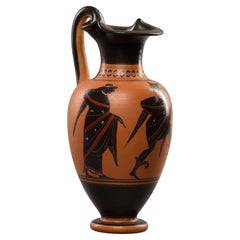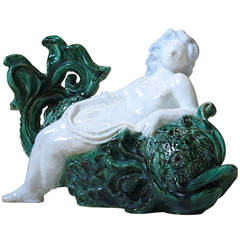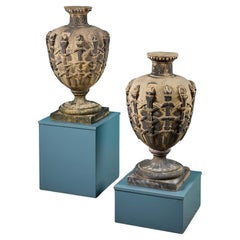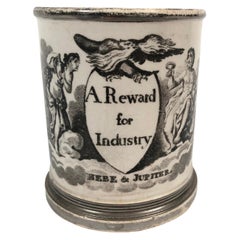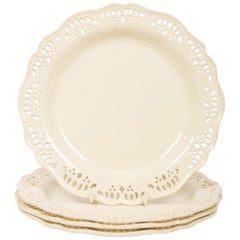Glazed Ceramics
12
to
1
9
3
12
12
12
608
547
456
165
100
72
50
24
19
19
13
12
7
1
1
5
3
4
3
1
12
4
4
3
1
12
5
2
2
2
2
1
Style: Neoclassical
Technique: Glazed
Ancient Pair Coffee Pots, Pasquale Rubati Manufacture Milan, 1770 circa
Located in Milano, IT
Pair of small coffee pots.
Manufacture of Pasquale Rubati
Milan, 1770 Circa
Maiolica polychrome decorated “a piccolo fuoco” (third fire).
a) height 7.87 x 5.51 x 3.93 in (20 x 14 x ...
Category
1760s Italian Neoclassical Antique Glazed Ceramics
Materials
Maiolica
Circa 1860 English Prattware Compote
Located in Chapel Hill, NC
Prattware compote, circa 1860, English. Marked No. 123. Prattware is lead-glazed earthenware produced in English from the 1790s thru much of the 19th century. Creamware body decorate...
Category
1860s English Neoclassical Antique Glazed Ceramics
Materials
Ceramic
Limoges France, Biscuit Child Bust, Stand with Dark Blue Glaze, Classic Style
Located in Copenhagen, DK
Limoges France. Biscuit child bust. Stand with dark blue glaze.
Classic style. Early 20th century.
Measures: 13.5 x 7 cm.
In excellent condition.
Stam...
Category
Early 20th Century French Neoclassical Glazed Ceramics
Materials
Ceramic
Two Pairs of Italian Maiolica Baskets, circa 1780
Located in Milano, IT
Two pairs of maiolica baskets
Antonio Ferretti Manufacture
Lodi, circa 1770-1790
Maiolica polychrome decorated “a piccolo fuoco” (third fire).
Measures: A) Height 3.54 x 6.69 x 9.84 in (9 x 17 x 25 cm);
B) Height 3.93 x 7.48 x 11.02 in (10 x 19 x 28 cm).
Total weight 4.85 lb (2.200 kg)
State of conservation:
A) One of the smaller baskets has some areas of restoration, the other slight chipping from use;
B) One of the larger baskets is intact and the other shows a clearly glued break.
The mold with which the baskets were forged simulates a wicker weave.
The two larger works have high, vertical walls, with branch-shaped handles penetrating the weave. The painted decorations, small polychrome flowers applied only externally, highlight the points where the weaves intersect.
The decision to leave the center of the basket devoid of decoration is highly unusual, but given the size and complexity of the shape, as well as the quality of the enamel, it is possible to hypothesize that it represents a precise choice in manufacturing or for a particular client.
The two smaller baskets have small, twisted handles and, on the outside, reproduce more decisively the characteristic wicker weave, obtained through thin molded lines. The interior exhibits a rich, typical decoration of naturalistic flowers: a bunch centered around a main flower and secondary stems accompanied by small “semis”. The exterior of these works is also adorned with small little flowers where the weaves intersect.
The size and morphological characteristics of the baskets confirm their attribution to the Lodi factory of Antonio Ferretti between 1770 and 1790, during its most successful period; by this point his original reworking of the "Strasbourg" decoration, known as "old Lodi", had achieved great fame even outside Italy.
This decorative choice represented a strong point of the Lodi factory, which established itself thanks to the vivid nature of the colors made possible by the introduction of a new technique perfected by Paul Hannong in Strasbourg and which Antonio Ferretti introduced in Italy. This production process, called “piccolo fuoco” (third fire), allowed the use of a greater number of colors than in the past; in particular, the purple of Cassius, a red made from gold chloride, was introduced. Its use allowed for many more tones and shades, from pink to purple.
The Ferretti family had started their maiolica manufacturing business in Lodi in 1725.
The forefather Simpliciano had started the business by purchasing an ancient furnace in 1725 and, indeed, we have evidence of the full activity of the furnaces from April of the same year (Novasconi-Ferrari-Corvi, 1964, p. 26 n. 4). Simpliciano had started a production of excellence also thanks to the ownership of clay quarries in Stradella, not far from Pavia. The production was so successful that in 1726 a decree of the Turin Chamber came to prohibit the importation of foreign ceramics, especially from Lodi, to protect internal production (G. Lise, La ceramica a Lodi, Lodi 1981, p. 59).
In its initial stages, the manufacture produced maolicas painted with the “a gran fuoco” (double fire) technique, often in turquoise monochrome, with ornamentation derived from compositional modules in vogue in Rouen in France. This was also thanks to the collaboration of painters like Giorgio Giacinto Rossetti, who placed his name on the best specimens next to the initials of the factory.
In 1748 Simpliciano made his will (Gelmini, 1995, p. 30) appointing his son Giuseppe Antonio (known as Antonio) as universal heir. After 1750, when Simpliciano passed away, Antonio was directly involved in the maiolica factory, increasing its fortunes and achieving a reputation on a European level. Particularly important was the aforementioned introduction in 1760 of the innovative “a piccolo fuoco” (third fire) processing, which, expanding the ornamental repertoire with Saxon-inspired floral themes, could commercially compete with the German porcelains that had one of its most renowned offerings in the naturalistic Deutsche Blumen. Antonio Ferretti understood and promoted this technique and this decoration, proposing it in a fresher and more corrective version, less linked to botanical tables...
Category
1770s Italian Neoclassical Antique Glazed Ceramics
Materials
Maiolica
Italian Neoclassical White Glazed Ceramic Urn, Large Scale
By Ceccarelli
Located in Stamford, CT
This classic Tuscan vase is a refined decorative complement to both traditional and contemporary interiors. Handcrafted of ceramic and glazed white it feat...
Category
Mid-20th Century Italian Neoclassical Glazed Ceramics
Materials
Ceramic
Early 20th C Terra Cotta Neoclassical Ewer
Located in Troy, MI
Circa 1920s red clay ewer with classical figures etched and painted in black. Found in England. Unknown maker. No cracks, chips or repairs found. White blurs...
Category
Early 20th Century English Neoclassical Glazed Ceramics
Materials
Terracotta
Italian Maiolica Pharmacy Flasks Felice Clerici, Milan Circa 1770-1780
Located in Milano, IT
Two maiolica pharmacy flasks
Milan, Felice Clerici Manufacture, 1770-1780
They each measure 9.44 in (24 cm) in height x 6.10 in (15.5 cm) in diameter
lb 4 (kg 1.8)
State of conserva...
Category
1770s Italian Neoclassical Antique Glazed Ceramics
Materials
Maiolica
Pair of Early 20th Century Rudolfstadt Vases
Located in London, GB
A pair of Rudolfstadt Porcelain vases, very much in the Royal Worcester style, hand painted with floral subjects on a duck-egg background; the neck and foot of the vases decorated with bisque and gilt scrolls the necks enhanced by a gilt Florentine scroll.
Category
Early 20th Century German Neoclassical Glazed Ceramics
Materials
Porcelain
Four Italian Ancient Dishes, Lodi, circa 1770-1780
Located in Milano, IT
Assortment of 4 dishes with braided rim
Antonio Ferretti Manufacture
Lodi, circa 1770-1780
Maiolica polychrome decorated “a piccolo fuoco” (third fire).
Measures: 14 x 10 in (35.5 x 25.5 cm);
12.2 x 8.39 in (31 x 21.3 cm);
10.4 x 9.65 in (26.5 x 24.5 cm);
10.8 x 9.61 in (27.5 x 24.4 cm).
Weight: 4.4 lb (1.998 kg)
State of conservation: some chips due to use on the edges and on the parts in relief.
The four different dishes have a foot with a low lip from which extends a wide, flat, slanted rim resembling a basket weave. The small handles are painted green: they resemble wickerwork in the two oval dishes and take the form of a sinuous branch in the round ones.
The third fire decoration is inspired by the naturalistic floral botanical patterns on the ceramics produced by the Hannong family in Strasbourg. Here the pattern is defined by the rapidity and subtlety of the brushstrokes and the result is particularly tasteful, characterized by compositional intelligence and pictorial expertise.
A main corolla, either a wild or garden rose, is set slightly off center in each well. From this extends a thin stem holding a small secondary bud and there are small field florets dotting the composition to lend volume to the delicate bunch of flowers.
On the brim, small polychrome flowers add color to the weave, accompanied by lanceolate leaves of a very intense green.
There exist few and very rare examples for comparison with this morphology: a round plate - entirely consistent with those in question - has been dated to around 1775 (S. Levy, Maioliche settecentesche lombarde e venete, Milano 1962, tav. 200). Two other dishes with a basket rim, but with parallel striped brim decoration, were exhibited in the 1995 exhibition on Lodi ceramics; the attribution to the Lombard town near Milan is therefore almost exclusively derived from the decoration called "alla rosa contornata" or "alla vecchia Lodi" and constitutes one of the most popular decorations during the eighteenth century. (M. L. Gelmini, in Maioliche lodigiane del '700 (cat. mostra Lodi), Milano 1995, pp. 31 p. 162-163 nn. 181-182).
This decorative choice represented a strong point of the Lodi factory, which established itself thanks to the vivid nature of the colors made possible by the introduction of a new technique perfected by Paul Hannong in Strasbourg and which Antonio Ferretti introduced in Italy. This production process, called “piccolo fuoco” (third fire), allowed the use of a greater number of colors than in the past; in particular, the purple of Cassius, a red made from gold chloride, was introduced. Its use allowed for many more tones and shades, from pink to purple.
The Ferretti family had started their Maiolica manufacturing business in Lodi in 1725.
The forefather Simpliciano had started the business by purchasing an ancient furnace in 1725 and, indeed, we have evidence of the full activity of the furnaces from April of the same year (Novasconi-Ferrari-Corvi, 1964, p. 26 n. 4). Simpliciano had started a production of excellence also thanks to the ownership of clay quarries in Stradella, not far from Pavia. The production was so successful that in 1726 a decree of the Turin Chamber came to prohibit the importation of foreign ceramics, especially from Lodi, to protect internal production (G. Lise, La ceramica a Lodi, Lodi 1981, p. 59).
In its initial stages, the manufacture produced maolicas painted with the “a gran fuoco” (double fire) technique, often in turquoise monochrome, with ornamentation derived from compositional modules in vogue in Rouen in France. This was also thanks to the collaboration of painters like Giorgio Giacinto Rossetti, who placed his name on the best specimens next to the initials of the factory.
In 1748 Simpliciano made his will (Gelmini, 1995, p. 30) appointing his son Giuseppe Antonio (known as Antonio) as universal heir. After 1750, when Simpliciano passed away, Antonio was directly involved in the Maiolica factory, increasing its fortunes and achieving a reputation on a European level. Particularly important was the aforementioned introduction in 1760 of the innovative “a piccolo fuoco” (third fire) processing, which, expanding the ornamental repertoire with Saxon-inspired floral themes, could commercially compete with the German porcelains that had one of its most renowned offerings in the naturalistic Deutsche Blumen. Antonio Ferretti understood and promoted this technique and this decoration, proposing it in a fresher and more corrective version, less linked to botanical tables...
Category
1770s Italian Neoclassical Antique Glazed Ceramics
Materials
Maiolica
Villafeliche Jug, Aragon, Spain, 18th Century
Located in Madrid, ES
Late Baroque pottery jug made and decorated with high temperature glazes over a white slip of tin. These motifs are combined with enameled decorations in relief obtained mold. The typology of the piece combines Italian jug with handle ovoid belly and vertical bow, with the peak jug typically Spanish, characterized by the outgoing peak of the mouth. Decorations reveal the oriental influence, with large floral bouquets arranged asymmetrically and complex landscapes with architecture and palm trees, which remove some figures, such as totally Western. The reasons appear pincelados in manganese black, and colored with ocher, blue, green and red, mainly enamels. Aragon ceramic least a century old will be characterized by a strong own, combined with the influences of personality Talavera and Catalonia. You will have three main centers: Teruel, Muel and Villafeliche, the first two with tradition since the 16th century, and the third created in the late 17th century. The Villafeliche will generally be very popular ceramics...
Category
18th Century Spanish Neoclassical Antique Glazed Ceramics
Materials
Ceramic
Pair of 19th Century Meissen Busts
Located in London, GB
A fine pair of Meissen porcelain busts modelled as fine ladies in Elizabethan and late 18 century costume, Marie Antoinette and Elisabeth I, circa 1870 (crossed sword in blue undergl...
Category
Mid-19th Century German Neoclassical Antique Glazed Ceramics
Materials
Porcelain
19th Century Sevres Style Trio Jardinieres
Located in London, GB
An unusual trio of jardinière and cache-pots, in the Sevres style, hand-painted with love scenes after Watteau on one side whilst the other side is decorated with flower panels. Each...
Category
Late 19th Century French Neoclassical Antique Glazed Ceramics
Materials
Porcelain
Related Items
French Art Deco Glazed Ceramic Woman and Dolphin Sculpture
Located in Isle Sur La Sorgue, Vaucluse
Lovely glazed ceramic representation of a nude woman reclining on a dolphin's back. Craquelure finish on the woman. Signed and dated "GN, 1946."
Category
Mid-20th Century French Art Deco Glazed Ceramics
Pair of Neoclassical Style Antique Sandstone Garden Urns
Located in Wormelow, Herefordshire
This spectacular pair of neoclassical style antique sandstone garden urns were sourced from an estate in the west of Scotland circa 1800. Both decorative stone urns are of a large an...
Category
Late 18th Century Scottish Neoclassical Antique Glazed Ceramics
Materials
Sandstone
Pair of Large Neoclassical Urns
Located in New York, NY
Pair of large neoclassical urns. Grand tour patinated copper craters after the antique with swan-form handles from Naples. Italy, early 19th century.
Dimension: 24.5" H x 15" D X 1...
Category
Early 19th Century Italian Grand Tour Antique Glazed Ceramics
Materials
Copper
19th Century Neoclassical Bronze Dore Urn Signed F. Levillain
Located in Savannah, GA
19th century neoclassical signed bronze doré urn with handles and adorned with elaborate roman scenes. Signed stamped F. Levillain. Ferdinand Levillain...
Category
19th Century French Neoclassical Antique Glazed Ceramics
Materials
Bronze
Bernard Leach Midcentury Studio Pottery Ash Glazed Coffee Pot
Located in Bishop's Stortford, Hertfordshire
A stylish midcentury ash glazed handcrafted Studio Pottery coffee pot by renowned English potter Bernard Leach CBE (British, 1887-1979) and made at ...
Category
20th Century English Mid-Century Modern Glazed Ceramics
Materials
Stoneware
Studio Pottery Weed Pot, circa 1975
Located in Costa Mesa, CA
Studio Pottery weed pot / vase. circa 1975.
Category
20th Century American Mid-Century Modern Glazed Ceramics
Materials
Ceramic
Pair of Large Italian Urns
Located in Hudson, NY
Stamp says: Arte Italica, Made in Italy.
Category
20th Century Italian Glazed Ceramics
Materials
Ceramic
Glazed Terracotta Antique Urn
Located in Austin, TX
A 19th century antique glazed terra cotta urn from Biot, France. We love the character and patina on this beautiful and impressive jardinière.
Category
1880s French Antique Glazed Ceramics
Materials
Terracotta
Aldo Londi Bitossi Kwan Yin, Ceramic, Blue Buddha Bust
By Bitossi, Aldo Londi
Located in New York, NY
Aldo Londi Bitossi Kwan Yin, Ceramic, Buddha Bust, Blue. Beautiful and calming female Buddha glazed in a vibrant dark reflex blue. According to one legend, Kwan Yin was an Indian Pri...
Category
1960s Italian Mid-Century Modern Vintage Glazed Ceramics
Materials
Ceramic
Mid-Century French Hand Painted Barbotine Ceramic Fruit Basket Centerpiece
Located in Dallas, TX
Decorate a tabletop with this colorful, majolica basket composition. Crafted in France circa 1960, the centerpiece features a realistic assortment of fruits and vegetables in high re...
Category
Mid-20th Century French Glazed Ceramics
Materials
Ceramic, Majolica
Camille Tharaud for Limoges Little Girl Biscuit Bust
By Limoges
Located in Antwerp, BE
Gorgeous porcelain busts of Louise Brongniart in bisque porcelain on royal blue enameled base, by Tharaud, Limoges, after the originals by Jean-Antoine Houdon (1741-1828). Louise was...
Category
Mid-20th Century French Mid-Century Modern Glazed Ceramics
Materials
Gold
Pair of Chinese Jun Ware Bowls, Yuan Dynasty
Located in Houston, TX
Pair of Chinese Jun ware bowls, Yuan dynasty (circa 1250-1400): Large Jun Yao, purple splashed stone ware bowl Yuan Dynasty, China. Well potted, on a neatly cu...
Category
15th Century and Earlier Chinese Antique Glazed Ceramics
Materials
Porcelain, Stoneware
Previously Available Items
English Staffordshire Pottery Child's Cup a Reward for Industry
Located in Essex, MA
A small English neoclassical Staffordshire black transfeware pottery cup with the words a reward for Industry printed on a shield, in the center, surmounted by an eagle and flanked, ...
Category
Early 19th Century English Neoclassical Antique Glazed Ceramics
Materials
Earthenware
Four Antique Wedgwood Pierced Creamware Dishes England 18th Century
By Wedgwood
Located in Katonah, NY
We are pleased to offer this group of four antique Wedgwood pierced creamware dishes made in 18th century England, circa 1785.
The dishes have twelve groups of piercings, and a sligh...
Category
Late 18th Century English Neoclassical Antique Glazed Ceramics
Materials
Creamware
Solid Agateware Vase 18th Century Made by Neale & Co.
By Neale & Co.
Located in Katonah, NY
This 18th century small vase is a gem of solid agateware. It was made of compositions of pigment-infused clay that look as much like natural stone as the stone itselfIt. The process...
Category
Late 18th Century English Neoclassical Antique Glazed Ceramics
Materials
Earthenware
Rare Large 19th Century Porcelain Group of Lovers
Located in London, GB
A delightful late 19th century porcelain group of lovers in 18th century dress, on horseback, surrounded by a hand-painted and encrusted flowers, on a rococo white and gilt base. The...
Category
1880s German Neoclassical Antique Glazed Ceramics
Materials
Porcelain
19th Century Minton Vase and Cover
By Minton
Located in London, GB
A very delicately painted Minton vase and cover. On one panel painted with romantic couple and on the back panel painted with fine bouquet of flowers an...
Category
Mid-19th Century English Neoclassical Antique Glazed Ceramics
Materials
Porcelain
Hache a Tours Blue and Gilded Ceramic Vase
By Hache
Located in Bochum, NRW
Hache à Tours.
Baluster shape, cobalt blue and gilded ceramic vase in the vein of sevres with decor of a trophy with flower basket, quiver and flaming torch and falls of natural ...
Category
Early 20th Century French Neoclassical Glazed Ceramics
Materials
Ceramic
Mid-19th Century Apt Ware Mixed Earths Pitcher
By Apt
Located in Katonah, NY
A French, mixed earths, Apt ware pitcher decorated with brown, black and cream colored earthenware (terre mêlée). The tight multicolored patterns were fo...
Category
Mid-19th Century French Neoclassical Antique Glazed Ceramics
Materials
Earthenware
Antique Creamware Dish
Located in Katonah, NY
A fluted creamware deep dish with feather edge border, four impressed clamshells and pierced neoclassical design. The reticulated decoration is crisp
and well executed.
Category
1810s English Neoclassical Antique Glazed Ceramics
Materials
Creamware, Earthenware
Pair Terra Cotta Urns With Gilded Trim
Located in Troy, MI
Pair circa 1930s tall neoclassical style terra cotta urns with plinth base, gilded details including a wreath and acanthus leaves on the handles and ...
Category
1930s Unknown Neoclassical Vintage Glazed Ceramics
Recently Viewed
View AllMore Ways To Browse
Italian Glazed Pottery Bird
Gustavsberg Horse
Minton Pedestal
Salt Glaze Dishes
Vallauris Fish Plates
Vintage Stoneware Mug
Vintage Stoneware Mugs
16th Century Renaissance Italy Majolica
Compagnie Des Indes
Lettuce Leaf
Vintage Ceramic Cooking Pots
Retro White Ironstone
Royal Doulton Arts And Crafts
Stoneware Limoges
Ashworth China
Blue Dragon Pot
Ground Squirrel
Japanese Stoneware Plate



